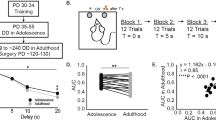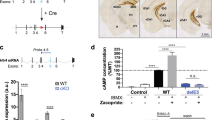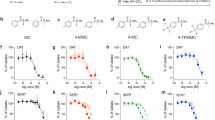Abstract
Animal models are making an increasing contribution to our understanding of the psychology and brain mechanisms underlying behavioral inhibition and impulsivity. The aim here was to develop, for the first time, a mouse analog of the stop-signal reaction time task with high translational validity in order to be able to exploit this species in genetic and molecular investigations of impulsive behaviors. Cohorts of mice were trained to nose-poke to presentations of visual stimuli. Control of responding was manipulated by altering the onset of an auditory ‘stop-signal’ during the go response. The anticipated systematic changes in action cancellation were observed as stopping was made more difficult by placing the stop-signal closer to the execution of the action. Excitotoxic lesions of medial prefrontal cortex resulted in impaired stopping, while the clinically effective drugs methylphenidate and atomoxetine enhanced stopping abilities. The specific 5-HT2C receptor antagonist SB242084 also led to enhanced response control in this task. We conclude that stop-signal reaction time task performance can be successfully modeled in mice and is sensitive to prefrontal cortex dysfunction and drug treatments in a qualitatively similar manner to humans and previous rat models. Additionally, using this model we show novel and highly discrete effects of 5-HT2C receptor antagonism that suggest manipulation of 5-HT2C receptor function may be of use in correcting maladaptive impulsive behaviors and provide further evidence for dissociable contributions of serotonergic transmission to response control.
Similar content being viewed by others
Log in or create a free account to read this content
Gain free access to this article, as well as selected content from this journal and more on nature.com
or
References
Alderson RM, Rapport MD, Kofler MJ (2007). Attention-deficit/hyperactivity disorder and behavioral inhibition: a meta-analytic review of the stop-signal paradigm. J Abnorm Child Psychol 35: 745–758.
Arnsten AF (2011). Catecholamine influences on dorsolateral prefrontal cortical networks. Biol Psychiatry 69: e89–e99.
Arnsten AF, Rubia K (2012). Neurobiological circuits regulating attention, cognitive control, motivation, and emotion: disruptions in neurodevelopmental psychiatric disorders. J Am Acad Child Adolesc Psychiatry 51: 356–367.
Aron AR, Dowson JH, Sahakian BJ, Robbins TW (2003). Methylphenidate improves response inhibition in adults with attention-deficit/hyperactivity disorder. Biol Psychiatry 54: 1465–1468.
Balcioglu A, Ren JQ, McCarthy D, Spencer TJ, Biederman J, Bhide PG (2009). Plasma and brain concentrations of oral therapeutic doses of methylphenidate and their impact on brain monoamine content in mice. Neuropharmacology 57: 687–693.
Bari A, Eagle DM, Mar AC, Robinson ES, Robbins TW (2009). Dissociable effects of noradrenaline, dopamine, and serotonin uptake blockade on stop task performance in rats. Psychopharmacology (Berl) 205: 273–283.
Bari A, Mar AC, Theobald DE, Elands SA, Oganya KC, Eagle DM et al (2011). Prefrontal and monoaminergic contributions to stop-signal task performance in rats. J Neurosci 31: 9254–9263.
Bonelli RM, Cummings JL (2007). Frontal-subcortical circuitry and behavior. Dialogues Clin Neurosci 9: 141–151.
Boulougouris V, Robbins TW (2010). Enhancement of spatial reversal learning by 5-HT2C receptor antagonism is neuroanatomically specific. J Neurosci 30: 930–938.
Boulougouris V, Tsaltas E (2008). Serotonergic and dopaminergic modulation of attentional processes. Prog Brain Res 172: 517–542.
Broos N, Schmaal L, Wiskerke J, Kostelijk L, Lam T, Stoop N et al (2012). The relationship between impulsive choice and impulsive action: a cross-species translational study. PLoS One 7: e36781.
Bruno KJ, Freet CS, Twining RC, Egami K, Grigson PS, Hess EJ (2007). Abnormal latent inhibition and impulsivity in coloboma mice, a model of ADHD. Neurobiol Dis 25: 206–216.
Carter JD, Farrow M, Silberstein RB, Stough C, Tucker A, Pipingas A (2003). Assessing inhibitory control: a revised approach to the stop signal task. J Atten Disord 6: 153–161.
Chamberlain SR, Muller U, Blackwell AD, Clark L, Robbins TW, Sahakian BJ (2006). Neurochemical modulation of response inhibition and probabilistic learning in humans. Science 311: 861–863.
Dalley JW, Roiser JP (2012). Dopamine, serotonin and impulsivity. Neuroscience 215: 42–58.
Davis JA, Gould TJ (2007). Atomoxetine reverses nicotine withdrawal-associated deficits in contextual fear conditioning. Neuropsychopharmacology 32: 2011–2019.
Del Campo N, Chamberlain SR, Sahakian BJ, Robbins TW (2011). The roles of dopamine and noradrenaline in the pathophysiology and treatment of attention-deficit/hyperactivity disorder. Biol Psychiatry 69: e145–e157.
Depue BE, Burgess GC, Willcutt EG, Ruzic L, Banich MT (2010). Inhibitory control of memory retrieval and motor processing associated with the right lateral prefrontal cortex: evidence from deficits in individuals with ADHD. Neuropsychologia 48: 3909–3917.
Doe CM, Relkovic D, Garfield AS, Dalley JW, Theobald DE, Humby T et al (2009). Loss of the imprinted snoRNA mbii-52 leads to increased 5-HTR2C pre-RNA editing and altered 5HT2CR-mediated behaviour. Hum Mol Genet 18: 2140–2148.
Eagle DM, Baunez C, Hutcheson DM, Lehmann O, Shah AP, Robbins TW (2008). Stop-signal reaction-time task performance: role of prefrontal cortex and subthalamic nucleus. Cereb Cortex 18: 178–188.
Eagle DM, Robbins TW (2003a). Inhibitory control in rats performing a stop-signal reaction-time task: effects of lesions of the medial striatum and d-amphetamine. Behav Neurosci 117: 1302–1317.
Eagle DM, Robbins TW (2003b). Lesions of the medial prefrontal cortex or nucleus accumbens core do not impair inhibitory control in rats performing a stop-signal reaction time task. Behav Brain Res 146: 131–144.
Eagle DM, Tufft MR, Goodchild HL, Robbins TW (2007). Differential effects of modafinil and methylphenidate on stop-signal reaction time task performance in the rat, and interactions with the dopamine receptor antagonist cis-flupenthixol. Psychopharmacology (Berl) 192: 193–206.
Evenden JL (1999). Varieties of impulsivity. Psychopharmacology (Berl) 146: 348–361.
Feola TW, de Wit H, Richards JB (2000). Effects of d-amphetamine and alcohol on a measure of behavioral inhibition in rats. Behav Neurosci 114: 838–848.
Fletcher PJ, Tampakeras M, Sinyard J, Higgins GA (2007). Opposing effects of 5-HT2A and 5-HT2C receptor antagonists in the rat and mouse on premature responding in the five-choice serial reaction time test. Psychopharmacology (Berl) 195: 223–234.
Franklin KBJ, Paxinos G (2008) The Mouse Brain in Stereotaxic Coordinates 3rd edn. Academic Press.
Grant JE, Potenza MN (eds) (2012) The Oxford Handbook of Impulse Control Disorders. Oxford University Press.
Griffin WC 3rd, McGovern RW, Bell GH, Randall PK, Middaugh LD, Patrick KS (2013). Interactive effects of methylphenidate and alcohol on discrimination, conditioned place preference and motor coordination in C57BL/6J mice. Psychopharmacology (Berl) 225: 613–625.
Helms CM, Gubner NR, Wilhelm CJ, Mitchell SH, Grandy DK (2008). D4 receptor deficiency in mice has limited effects on impulsivity and novelty seeking. Pharmacol Biochem Behav 90: 387–393.
Hogg RV, Craig AT (1995) Introduction to Mathematical Statistics 5th edn. Macmillan: New York.
Humby T, Laird FM, Davies W, Wilkinson LS (1999). Visuo-spatial attentional functioning in mice: interactions between cholinergic manipulations and genotype. Eur J Neurosci 11: 2813–2823.
Humby T, Wilkinson LS (2011). Assaying dissociable elements of behavioural inhibition and impulsivity: translational utility of animal models. Curr Opin Pharmacol 11: 534–539.
Humby T, Wilkinson LS, Dawson G (2005). Assaying aspects of attention and impulse control in mice using the 5-choice serial reaction time task. Curr Protoc Neurosci Chapter 8 Unit 8.5H.
Kishore S, Stamm S (2006). Regulation of alternative splicing by snoRNAs. Cold Spring Harb Symp Quant Biol 71: 329–334.
Koda K, Ago Y, Cong Y, Kita Y, Takuma K, Matsuda T (2010). Effects of acute and chronic administration of atomoxetine and methylphenidate on extracellular levels of noradrenaline, dopamine and serotonin in the prefrontal cortex and striatum of mice. J Neurochem 114: 259–270.
Lambourne SL, Humby T, Isles AR, Emson PC, Spillantini MG, Wilkinson LS (2007). Impairments in impulse control in mice transgenic for the human FTDP-17 tauV337M mutation are exacerbated by age. Hum Mol Genet 16: 1708–1719.
Logan GD (1994). On the ability to inhibit thought and action: a users’ guide to the stop signal paradigm. In Dagenbach D, Carr TH (eds). Inhibitory Processes in Attention, Memory, and Language. Academic Press: San Diego. pp 189–239.
Mar AC, Walker AL, Theobald DE, Eagle DM, Robbins TW (2011). Dissociable effects of lesions to orbitofrontal cortex subregions on impulsive choice in the rat. J Neurosci 31: 6398–6404.
Meltzer HY, Massey BW, Horiguchi M (2012). Serotonin receptors as targets for drugs useful to treat psychosis and cognitive impairment in schizophrenia. Curr Pharm Biotechnol 13: 1572–1586.
Paterson NE, Wetzler C, Hackett A, Hanania T (2012). Impulsive action and impulsive choice are mediated by distinct neuropharmacological substrates in rat. Int J Neuropsychopharmacol 15: 1473–1487.
Pliszka SR, Glahn DC, Semrud-Clikeman M, Franklin C, Perez R 3rd, Xiong J et al (2006). Neuroimaging of inhibitory control areas in children with attention deficit hyperactivity disorder who were treatment naive or in long-term treatment. Am J Psychiatry 163: 1052–1060.
Reynolds GP, Templeman LA, Zhang ZJ (2005). The role of 5-HT2C receptor polymorphisms in the pharmacogenetics of antipsychotic drug treatment. Prog Neuropsychopharmacol Biol Psychiatry 29: 1021–1028.
Robbins TW (2007). Shifting and stopping: fronto-striatal substrates, neurochemical modulation and clinical implications. Philos Trans R Soc Lond B Biol Sci 362: 917–932.
Robbins TW, Gillan CM, Smith DG, de Wit S, Ersche KD (2012). Neurocognitive endophenotypes of impulsivity and compulsivity: towards dimensional psychiatry. Trends Cogn Sci 16: 81–91.
Robinson ES, Dalley JW, Theobald DE, Glennon JC, Pezze MA, Murphy ER et al (2008b). Opposing roles for 5-HT2A and 5-HT2C receptors in the nucleus accumbens on inhibitory response control in the 5-choice serial reaction time task. Neuropsychopharmacology 33: 2398–2406.
Robinson ES, Eagle DM, Mar AC, Bari A, Banerjee G, Jiang X et al (2008a). Similar effects of the selective noradrenaline reuptake inhibitor atomoxetine on three distinct forms of impulsivity in the rat. Neuropsychopharmacology 33: 1028–1037.
Solanto MV, Abikoff H, Sonuga-Barke E, Schachar R, Logan GD, Wigal T et al (2001). The ecological validity of delay aversion and response inhibition as measures of impulsivity in AD/HD: a supplement to the NIMH multimodal treatment study of AD/HD. J Abnorm Child Psychol 29: 215–228.
Swann AC (2010). Mechanisms of impulsivity in bipolar disorder and related illness. Epidemiol Psichiatr Soc 19: 120–130.
Talpos JC, Wilkinson LS, Robbins TW (2006). A comparison of multiple 5-HT receptors in two tasks measuring impulsivity. J Psychopharmacol 20: 47–58.
Tannock R, Schachar RJ, Carr RP, Chajczyk D, Logan GD (1989). Effects of methylphenidate on inhibitory control in hyperactive children. J Abnorm Child Psychol 17: 473–491.
Winstanley CA (2011). The utility of rat models of impulsivity in developing pharmacotherapies for impulse control disorders. Br J Pharmacol 164: 1301–1321.
Winstanley CA, Theobald DE, Dalley JW, Glennon JC, Robbins TW (2004). 5-HT2A and 5-HT2C receptor antagonists have opposing effects on a measure of impulsivity: interactions with global 5-HT depletion. Psychopharmacology (Berl) 176: 376–385.
Acknowledgements
We thank Clive Mann and other members of the Behavioural Neuroscience Laboratory team in Cardiff for technical support and animal husbandry.
Author contributions
TH and LSW conceived the project and wrote the paper. JBE and TH performed the experiments; ACR and MAG performed the surgery and conducted the histological processing and lesion analysis. TH and LSW analyzed the data.
Author information
Authors and Affiliations
Corresponding authors
Additional information
Supplementary Information accompanies the paper on the Neuropsychopharmacology website
Supplementary information
Rights and permissions
About this article
Cite this article
Humby, T., Eddy, J., Good, M. et al. A Novel Translational Assay of Response Inhibition and Impulsivity: Effects of Prefrontal Cortex Lesions, Drugs Used in ADHD, and Serotonin 2C Receptor Antagonism. Neuropsychopharmacol 38, 2150–2159 (2013). https://doi.org/10.1038/npp.2013.112
Received:
Revised:
Accepted:
Published:
Issue date:
DOI: https://doi.org/10.1038/npp.2013.112
Keywords
This article is cited by
-
Effects of 5-HT2C, 5-HT1A receptor challenges and modafinil on the initiation and persistence of gambling behaviours
Psychopharmacology (2020)
-
Attention deficit hyperactivity disorder (ADHD) in phenotypically similar neurogenetic conditions: Turner syndrome and the RASopathies
Journal of Neurodevelopmental Disorders (2017)
-
Genetic and Pharmacological Modulation of the Steroid Sulfatase Axis Improves Response Control; Comparison with Drugs Used in ADHD
Neuropsychopharmacology (2014)
-
Recent Translational Findings on Impulsivity in Relation to Drug Abuse
Current Addiction Reports (2014)
-
Brain-expressed imprinted genes and adult behaviour: the example of Nesp and Grb10
Mammalian Genome (2014)



